An Original Stone Eagle Comes Home to Penn Station in NYC
A 7,500-pound eagle sculpture from the top of the original 1910 Penn Station building has been returned after years in hiding!


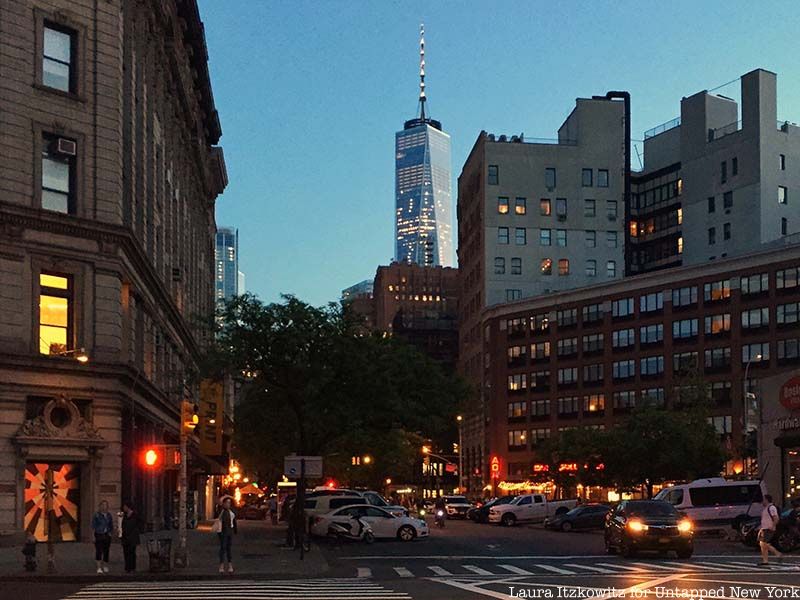
Tribeca — or TriBeCa as it’s sometimes spelled — may be known for having some of Manhattan’s most expensive real estate, but it wasn’t actually a single cohesive neighborhood until the late 1960s. The moniker stands for Triangle Below Canal — though it’s not actually a triangle — and the modern-day neighborhood stretches from Canal Street down to Vesey Street and from Broadway all the way to the Hudson River.
During the early days of Dutch New Amsterdam, the area was mostly farmland. As Manhattan expanded north, much of the area came to be owned by Trinity Church, which created the beautiful St. John’s Park anchored by St. John’s Chapel and rented out plots of land on 99-year leases. Just south of Tribeca, where the World Trade Center is now, used to be Washington Market, a massive wholesale market that turned the area into a center for food production and sales. The area around Broadway was a posh shopping district for clothes and textiles until the Great Fire of 1835.
When Commodore Cornelius Vanderbilt created the Hudson River Railroad, which ran through the Meatpacking District, he destroyed St. John’s Park, replacing it with St. John’s Terminal, which he topped with a massive statue of himself. Read on to discover where to see an homage to St. John’s Chapel and nine other secrets of Tribeca.
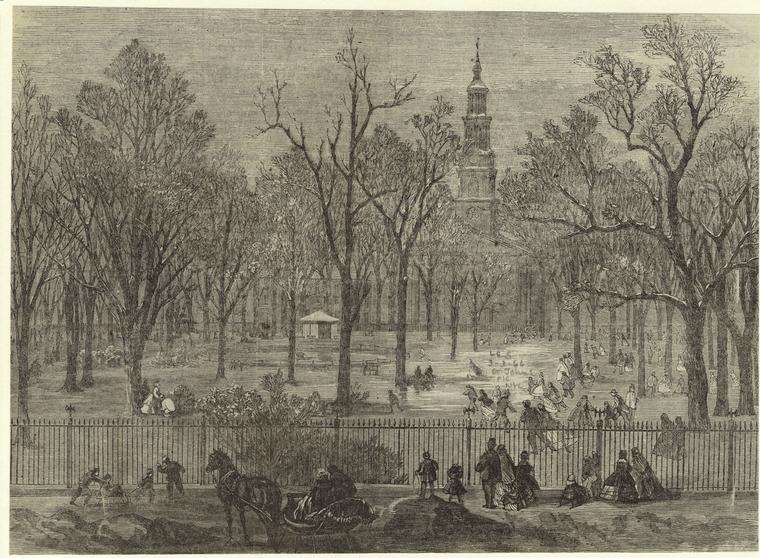
In the late 1700s and early 1800s, Hudson Square — informally known as St. John’s Park — near Canal and Varick Streets was considered the city’s poshest residential square. Trinity Church hired John McComb, who also designed City Hall, to build the beautiful Georgian-style St. John’s Chapel inspired by St. Martin’s in the Field in London, to anchor the square, hoping to attract well-to-do residents. Predating Gramercy Park, it was New York City’s first private park, and by 1830 was considered the city’s most prestigious address.
Yet just three blocks south was a brothel district on and around Thomas Street. Much attention was drawn to the area in 1836, when the 23-year-old prostitute Helen Jewett was murdered in her bed. The subsequent investigation and trial of her client Richard Robinson caused a media sensation unlike anything seen before it. The area remained a hotbed for prostitution until the mid-1800s, with Chapel Street (later renamed West Broadway) as the most notorious street.
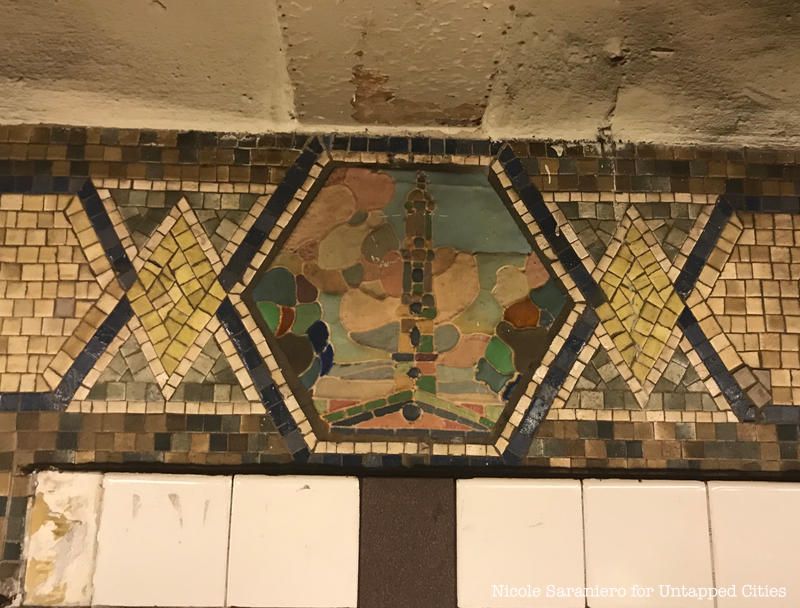
As development continued northward, and New York’s genteel society moved to Washington Square Park and Gramercy Park, St. John’s Park started to decline. But it was Commodore Cornelius Vanderbilt who put the nail in the coffin when he purchased the park from Trinity Church in 1867 and razed it to make way for St. John’s Terminal, the terminal station for his Hudson River Railroad, which earned 10th Avenue in the Meatpacking District the moniker “Death Avenue.”
With the park destroyed, St. John’s Chapel lost most of its parishioners and by 1912, it was down to one service a week. When the city decided to expand Varick Street in order to continue constructing the subway, the new plans would have made the chapel jut out into the street. There were efforts to save it, but in 1918, it was demolished. Though you won’t find any vestiges of the chapel anymore, you can see an homage to it in the mosaics at the Canal Street 1 train station.
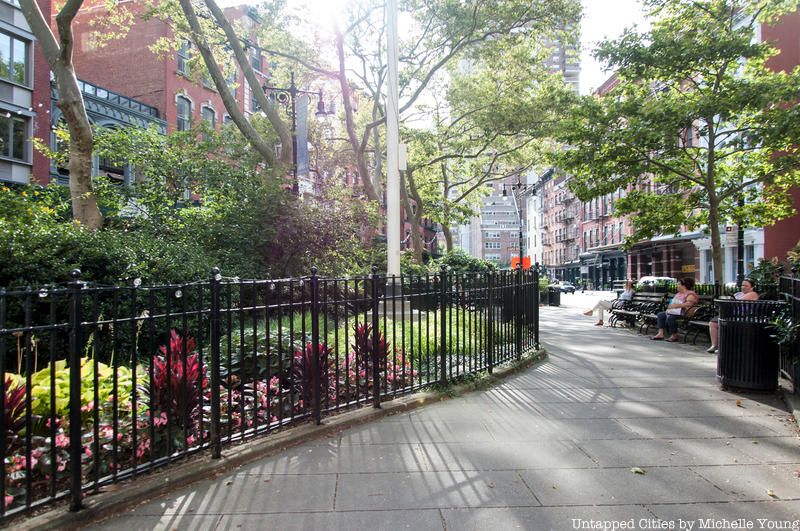
In 1797, around the same time that St. John’s Park was laid out, Trinity Church sold the 0.12-acre plot of land at Hudson and Duane Streets to the city for five dollars for use as a public park. One of New York City’s oldest parks, it was, in fact, the first public space acquired by the city specifically for use as a public park. The city named the park and the adjacent street after James Duane, New York City’s first mayor after the Revolutionary War, who also happened to be a prominent parishioner at Trinity Church.
Initially an open green space, the park was later enclosed by an iron fence. It underwent a few redesigns over the years, including a restoration in the 1990s after being severely neglected. It’s surrounded by beautiful 19th-century buildings.
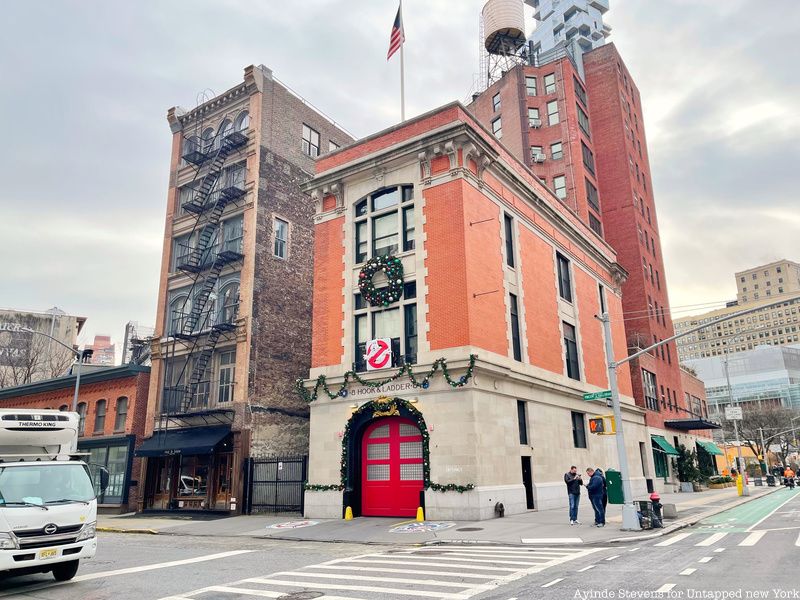
In the 1910s, in order to extend the IRT, Varick Street had to be widened by 35 feet. Many buildings were torn down, including the aforementioned St. John’s Chapel. Just a block south, the 1903 Beaux-Arts fire station constructed for the Hook & Ladder company at the corner of Varick and North Moore Streets was actually sliced in half. It originally had two garage doors and accommodated two fire engines. The station was so beautiful that rather than demolishing it, the city managed to keep half of it intact.
In 1984, the fire station gained international fame as a filming location for Ghostbusters starring Bill Murray. A Ghostbusters sign still hangs inside the station, but unfortunately it’s not open to the public for visits, as it’s still a working firehouse. It was also featured in an episode of Seinfeld.
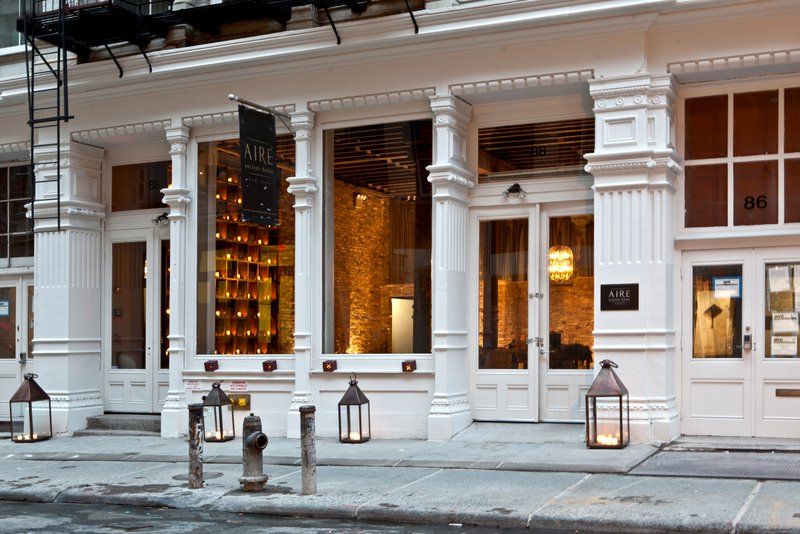
Though SoHo is famous for its distinctive cast iron architecture, some of the earliest examples of the architectural style can be found in Tribeca. Built in 1849, the Edgar Laing Stores designed by cast iron pioneer James Bogardus was the earliest example of a complete cast iron building façade in New York City. Located in the Washington Market District, it was used as a prototype for the cast iron buildings that followed. Unfortunately, it was dismantled and the pieces were stolen.
However, many cast iron buildings in Tribeca remain, as much of the neighborhood is made up of five historic districts: Tribeca North, Tribeca South, Tribeca East, Tribeca West, and Tribeca South Extension. One of the 19th-century cast iron buildings in the Tribeca East Historic District is now home to the Aire Ancient Baths, a luxurious bathhouse and spa. The building was constructed in 1881 by a promising young architect named J. Morgan Slade, who unfortunately didn’t live long enough to see his masterpiece completed.
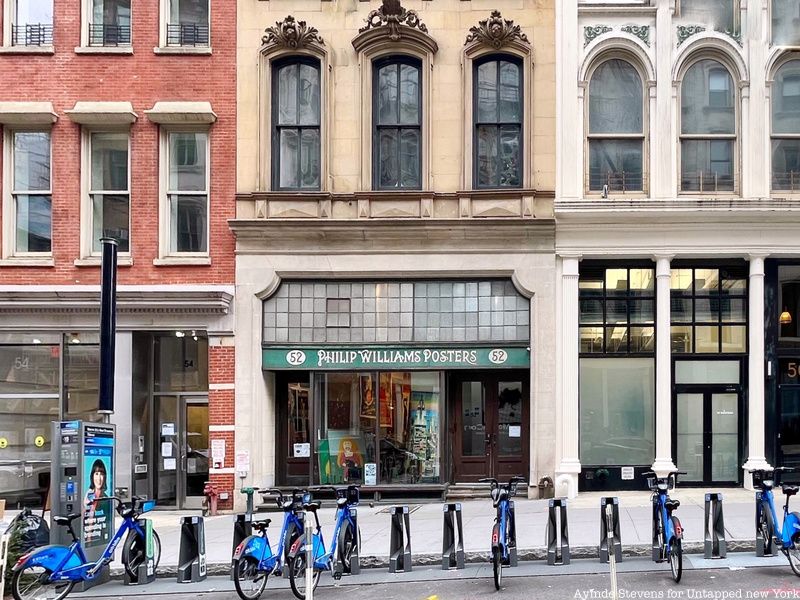
For a historic relic you can frame and hang on your wall, make a trip to Philip Williams Posters on Chambers Street. Established in 1973, the shop boasts one of the world’s largest private collections of vintage posters. Spread out over 12,600 square feet, the shop has over 100,000 posters from the 1870s to the present.
Browsing the collection, you might find rare items like an original 1921 Bitter Campari poster, a 1910 Peugeot Cycles poster, posters from John F. Kennedy’s presidential campaign and inauguration, plus old issues of Life magazine, vintage maps, and more. There are posters by famous artists like Andy Warhol and Salvador Dali. The shop also sells original paintings.
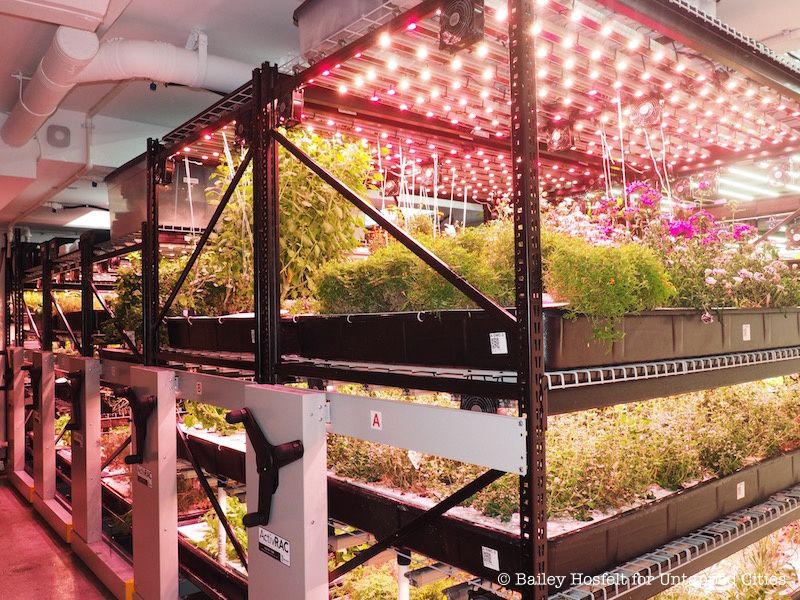
Those rare herbs like sweet Thai basil and zaatar majoram beloved by New York’s Michelin-starred chefs are being grown to order at Farm.One, a hydroponic farm hidden below Atera. Thanks to LED lighting and a climate controlled environment, Farm.One grows 700 varieties of produce, micro-greens, herbs, mushrooms, and edible flowers year-round.
The farm uses sustainable practices like vertical farming, no pesticides, and almost no water. The team delivers items the same day they’re harvested to restaurants and individuals in Manhattan and Brooklyn. They use reusable containers and make deliveries by bike or subway, ensuring that deliveries have no carbon footprint. Though the farm originally catered exclusively to chefs, it now offers subscription boxes for individuals ranging from $6 per week for a 3.5 ounce box of mixed baby and micro-greens to $40 per week for six 3.5 ounce containers of baby and micro-greens, one box of herbs and flowers, and a surprise.
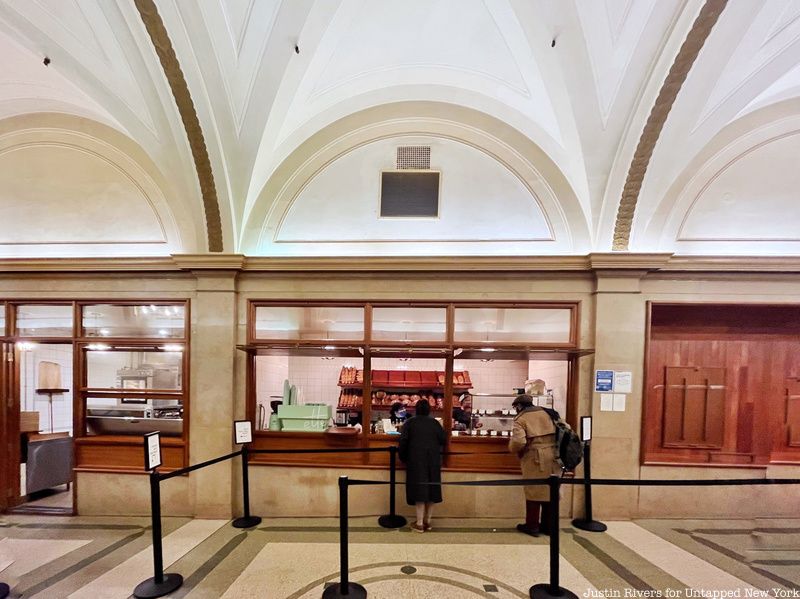
Originally opened in 2014 by Roger Gural in a hidden space inside an office building on Church Street, Arcade Bakery developed a cult following for its delicious baguettes and other hand-crafted breads and pastries. So when Gural announced he was planning to retire and shut the bakery down in 2019, chefs Riad Nasr and Lee Hanson of the nearby restaurant Frenchette offered to take it over. And though the pandemic delayed their takeover, they officially opened the space as Frenchette Bakery in October 2020.
“We loved Arcade, and we have long been fans of Roger and his bread,” Nasr told Eater. “When Arcade become available, we knew we wanted to keep the notion of the neighborhood bakery going.” They kept the space much the same as it was and still make the baguettes Arcade was known for. On the menu you’ll also find a city loaf with rye, wheat, and malted oat, fougasse with olive, thyme, and red pepper, and pastries such as croissants, kouign-amman, pain au chocolat, Sicilian pistachio croissants, and chocolate chip cookies.
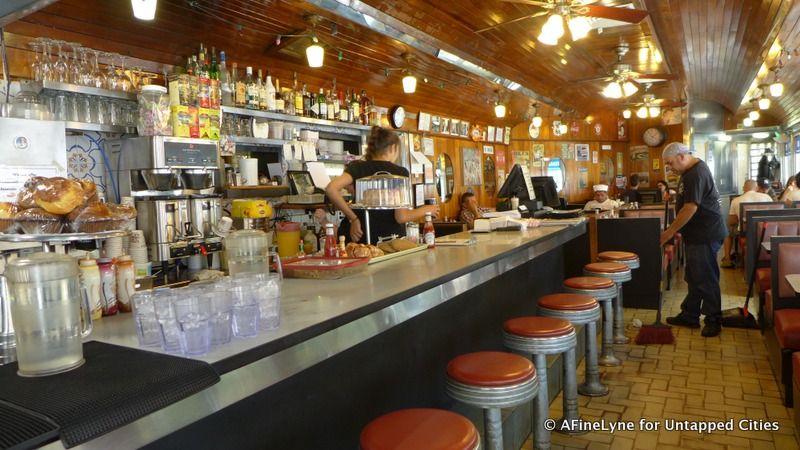
Sadly, New York City’s old-school standalone diners are being lost to rising real estate prices and gentrification, but a few of these stalwarts still stand. One such place is the Square Diner on Leonard Street in Tribeca, which is actually a triangle. No one seems to be sure when exactly the diner first opened its doors, but estimates put it in the 1920s, when it took the form of a wooden shack. The Pullman Dining Car Company in New Jersey created the train car-style form it currently has back in the 1940s.
The chrome and blue exterior is in keeping with the old-school interiors, which feature wood paneled walls and ceilings, red vinyl booths, and glass-block windows. TV shows such as Daredevil and Gotham have used it as a filming location. In addition to classic diner fare like waffles and eggs benedict, the Square Diner also serves healthy salads, fish tacos, and sandwiches.
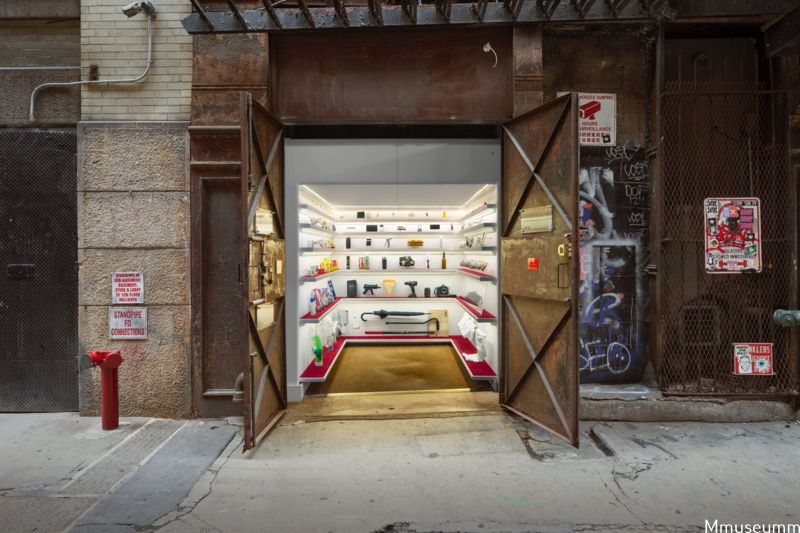
One of NYC’s top 10 off-the-radar museums, Mmuseumm is a tiny museum housed in a freight elevator on Cortlandt Alley on the Tribeca/Chinatown border. Founded by entrepreneur Alex Kalman and filmmakers Josh and Benny Safdie, Mmuseumm is a self-described “modern natural history museum” featuring an annually changing eccentric collection of objects displayed behind glass on shelves. A past exhibition included bullet-proof Disney backpacks, potato chip packets from around the world, and splatters of fake vomit.
In 2015, Kalman debuted Mmuseumm 2, a storefront window exhibition space next to the original Mmuseumm. For this even smaller space, Kalman’s mother, the artist Maira Kalman, recreated her mother Sara Berman’s closet. According to the New York Times, “The cable-knit sweaters, lace-up shoes and spare accessories that were once neatly arranged in her West Village apartment, along with mementos like her perfume and her box grater, are now displayed behind a pane of glass, like a diorama of compressed urban life.”
Next, read about the top 10 secrets of Chinatown and the top 10 secrets of the Financial District!
Subscribe to our newsletter